Physical and Mechanical Characteristics of Sustainable Concrete Comprising Industrial Waste Materials as a Replacement of Conventional Aggregate
Abstract
1. Introduction
2. Experimental Program
2.1. Materials
2.1.1. Cement
2.1.2. Lathe Iron Waste Dusts (LIWD)
2.1.3. Aggregates
2.1.4. Water
2.2. Mixing Regime
2.3. Samples Preparations
2.4. Test Samples
3. Results and Discussions
3.1. Slump Test
3.2. Densities of the Speecimen
3.3. Compressive Strength
3.4. Flexural Strength
3.5. Splitting Tensile Strength
3.6. Load-Displacement Characteristics
3.7. Ultrasonic Pulse Velocity (UPV)
4. Conclusions
- The replacement of fine aggregate with iron waste demonstrated significant influence on the compressive strength of concrete. The enhancement of compressive strength with the substitute of 5%, 10%, 15%, and 20% fine aggregate in sustainable concrete of iron waste expressed 5%, 13%, 31%, and 38%, respectively higher than the reference sample. However, the slump values were reduced up to 20.3% due to the heterogeneity and roughness of the iron waste.
- The dry density of the iron waste based sustainable concrete was increased up to 5% compared to the reference sample. Because of the higher unit weight of iron waste compared with the fine aggregate.
- The flexural strength significantly enhanced of 8%, 8%, 13%, and 19% compared with the reference sample by the replacement of fine aggregate of 5%, 10%, 15%, and 20%, respectively. This might be achieved by the iron waste particles delay the initiation of cracks into the concrete compared with the reference sample.
- The splitting tensile strength potentially increased up to 13% compared with the reference sample due to the roughness of the iron waste surface. Since this roughness of the surface make better interlocking between the aggregates.
- The displacement significantly reduced by 5%, 10%, 15%, and 20% comprising lathe iron waste in the samples which ensure the serviceability requirement might be achieved by this waste materials into the concrete.
- The iron waste meaningfully enhanced stiffness in the concrete samples due to higher density of the iron waste.
- The increment of iron waste in the concrete mixes were exhibited the improvement in UPV compared with the reference sample. The UPV improved due to the voids reduced by the iron waste and ensure dense concrete.
- Therefore, the lathe iron waste can be used as a construction material to produce sustainable concrete and to ensure a greener environment.
Author Contributions
Funding
Institutional Review Board Statement
Informed Consent Statement
Data Availability Statement
Acknowledgments
Conflicts of Interest
References
- Rashid, K.; Razzaq, A.; Ahmad, M.; Rashid, T.; Tariq, S. Experimental and analytical selection of sustainable recycled concrete with ceramic waste aggregate. Constr. Build. Mater. 2017, 154, 829–840. [Google Scholar] [CrossRef]
- Bassani, M.; Garcia, J.D.; Meloni, F.; Volpatti, G.; Zampini, D. Recycled coarse aggregates from pelletized unused concrete for a more sustainable concrete production. J. Clean. Prod. 2019, 219, 424–432. [Google Scholar] [CrossRef]
- Leao, S.; Bishop, I.; Evans, D. Assessing the demand of solid waste disposal in urban region by urban dynamics modelling in a GIS environment. Resour. Conserv. Recycl. 2001, 33, 289–313. [Google Scholar] [CrossRef]
- Jiang, Y.; Ling, T.-C.; Shi, C.; Pan, S.-Y. Characteristics of steel slags and their use in cement and concrete—A review. Resour. Conserv. Recycl. 2018, 136, 187–197. [Google Scholar] [CrossRef]
- Chen, H.; Su, R. Tension softening curves of plain concrete. Constr. Build. Mater. 2013, 44, 440–451. [Google Scholar] [CrossRef]
- Al-Tikrite, A.; Hadi, M.N. Mechanical properties of reactive powder concrete containing industrial and waste steel fibres at different ratios under compression. Constr. Build. Mater. 2017, 154, 1024–1034. [Google Scholar] [CrossRef]
- Alwaeli, M.; Nadziakiewicz, J. Recycling of scale and steel chips waste as a partial replacement of sand in concrete. Constr. Build. Mater. 2012, 28, 157–163. [Google Scholar] [CrossRef]
- Shishegaran, A.; Daneshpajoh, F.; Taghavizade, H.; Mirvalad, S. Developing conductive concrete containing wire rope and steel powder wastes for route deicing. Constr. Build. Mater. 2020, 232, 117184. [Google Scholar] [CrossRef]
- Rahman, A.; Ali, S.M.; Azeemuddin, S. Performance Analysis of Steel Scrap in Structural Concrete. IOSR-JMCE 2017, 14, 2278-1684. [Google Scholar] [CrossRef]
- Darji, S.P.; Borsadiya, K.J.; Momin, A.S.; Prajapati, G.P.R.G. Analysis of Compressive Strength of Concrete Using Steel Scrap. Development 2017, 4, 96–100. [Google Scholar]
- Shrivastava, P.; Joshi, D.Y. Reuse of lathe waste steel scrap in concrete pavements. Int. J. Eng. Res. Appl. 2014, 4, 45–54. [Google Scholar]
- Mello, E.; Ribellato, C.; Mohamedelhassan, E. Improving concrete properties with fibers addition. Int. J. Civ. Environ. Eng. 2014, 8, 249–254. [Google Scholar]
- Gawatre, D.W.; Haldkar, P.; Nanaware, S.; Salunke, A.; Shaikh, M.; Patil, A. Study on addition of lathe scrap to improve the mechanical properties of concrete. Int. J. Innov. Res. Sci. Eng. Technol. 2016, 5, 2319–8753. [Google Scholar]
- Vijayakumar, G.; Senthilnathan, P.; Pandurangan, K.; Ramakrishna, G. Impact and energy absorption characteristics of lathe scrap reinforced concrete. Int. J. Struct. Civ. Eng. Res. 2012, 1, 1–6. [Google Scholar]
- Ashok, S.P.; Suman, S.; Chincholkar, N. Reuse of steel scrap from lathe machine as reinforced material to enhance properties of concrete. Glob. J. Eng. Appl. Sci. 2012, 2, 2. [Google Scholar]
- Girskas, G.; Nagrockienė, D. The use of steel cord scrap in concrete. Constr. Sci. 2016, 18, 22–26. [Google Scholar] [CrossRef][Green Version]
- Mandloi, A.; Pathak, K. Utilization of Waste Steel Scrap for Increase in Strength of Concrete-Waste Management. Int. J. Sci. Res. Dev. 2015, 3, 1105–1107. [Google Scholar]
- ASTM C33/C33M. Standard Specification for Concrete Aggregates; ASTM: West Conshohocken, PA, USA, 2018. [Google Scholar]
- ASTM C1602/C1602M. Standard Specification for Mixing Water Used in the Production of Hydraulic Cement Concrete; ASTM: West Conshohocken, PA, USA, 2018. [Google Scholar]
- ASTM C192/C192M-19. Standard Practice for Making and Curing Concrete Test Specimens in the Laboratory; ASTM: West Conshohocken, PA, USA, 2019. [Google Scholar]
- ASTM C39/C39M. Standard Test Method for Compressive Strength of Cylindrical Concrete Specimens; ASTM: West Conshohocken, PA, USA, 2020. [Google Scholar]
- ASTM C496/C496M-11. Standard Test Method for Splitting Tensile Strength of Cylindrical Concrete Specimens; ASTM: West Conshohocken, PA, USA, 2004. [Google Scholar]
- ASTM C78/C78M-10. Standard Test Method for Flexural Strength of Concrete (Using Simple Beam with Third-Point Loading); ASTM: West Conshohocken, PA, USA, 2010. [Google Scholar]
- ASTM C597-16. Standard Test Method for Pulse Velocity through Concrete; ASTM: West Conshohocken, PA, USA, 2016. [Google Scholar]
- Wang, Q.; Yan, P.; Yang, J.; Zhang, B. Influence of steel slag on mechanical properties and durability of concrete. Constr. Build. Mater. 2013, 47, 1414–1420. [Google Scholar] [CrossRef]
- Netinger, I.; Bjegović, D.; Vrhovac, G. Utilisation of steel slag as an aggregate in concrete. Mater. Struct. 2011, 44, 1565–1575. [Google Scholar] [CrossRef]
- Papayianni, I.; Anastasiou, E. Production of high-strength concrete using high volume of industrial by-products. Constr. Build. Mater. 2010, 24, 1412–1417. [Google Scholar] [CrossRef]
- Özturan, T.; Çeçen, C. Effect of coarse aggregate type on mechanical properties of concretes with different strengths. Cem. Concr. Res. 1997, 27, 165–170. [Google Scholar] [CrossRef]
- Al-Negheimish, A.I.; Al-Sugair, F.H.; Al-Zaid, R.Z. Utilization of local steelmaking slag in concrete. J. King Saud Univ. Eng. Sci. 1997, 9, 39–54. [Google Scholar] [CrossRef]
- Alkhraisha, H.; Mhanna, H.; Tello, N.; Abed, F. Serviceability and Flexural Behavior of Concrete Beams Reinforced with Basalt Fiber-Reinforced Polymer (BFRP) Bars Exposed to Harsh Conditions. Polymers 2020, 12, 2110. [Google Scholar] [CrossRef] [PubMed]
- Li, Y.; Yang, P.; Wu, C.; Cheng, T.; Huang, C. A Study on Radiation Cooling Effect on Asphalt Concrete Pavement Using Basic Oxygen Furnace Slag to Replace Partial Aggregates. Sustainability 2021, 13, 3708. [Google Scholar] [CrossRef]
- Ahmmad, R.; Jumaat, M.Z.; Alengaram, U.J.; Bahri, S.; Rehman, M.A.; Hashim, H. Performance evaluation of palm oil clinker as coarse aggregate in high strength lightweight concrete. J. Clean. Prod. 2016, 112, 566–574. [Google Scholar] [CrossRef]
- Leslie, J.; Cheesman, W. An ultrasonic method of studying deterioration and cracking in concrete structures. J. Am. Concr. Inst. 1949, 21, 17–36. [Google Scholar]
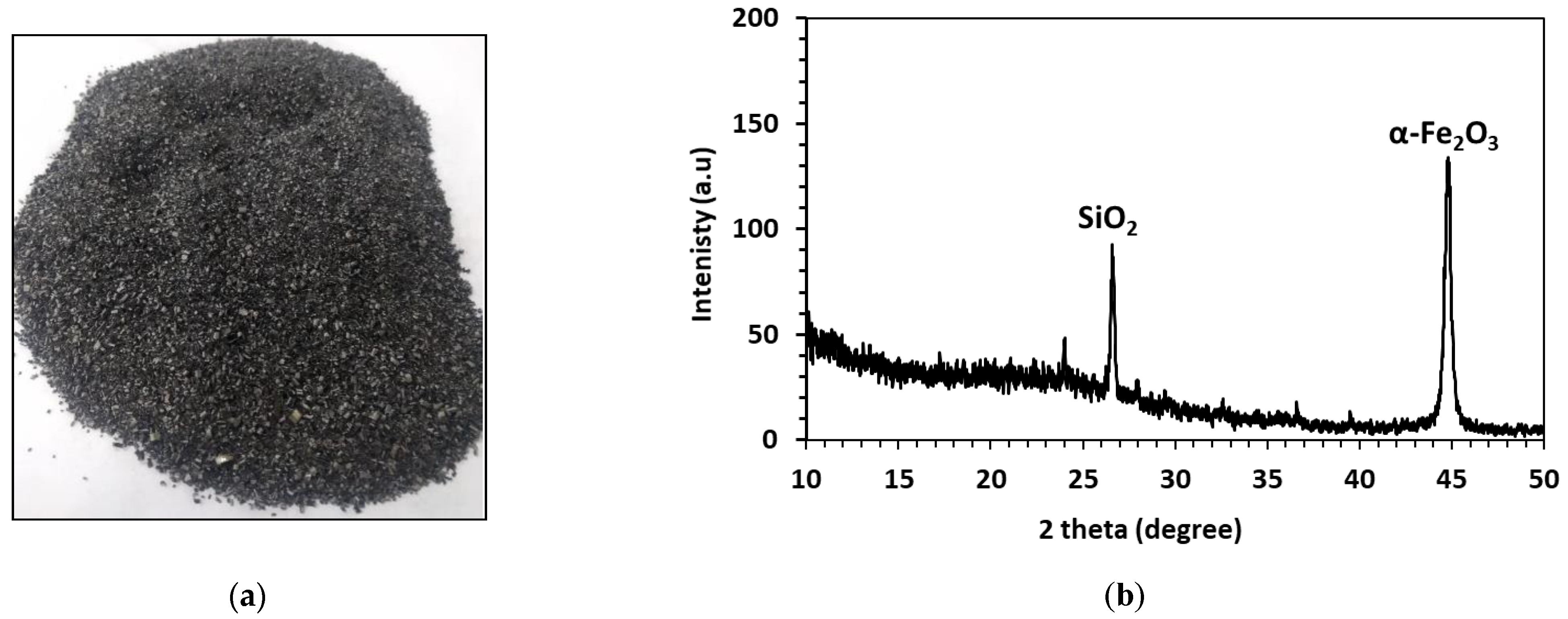
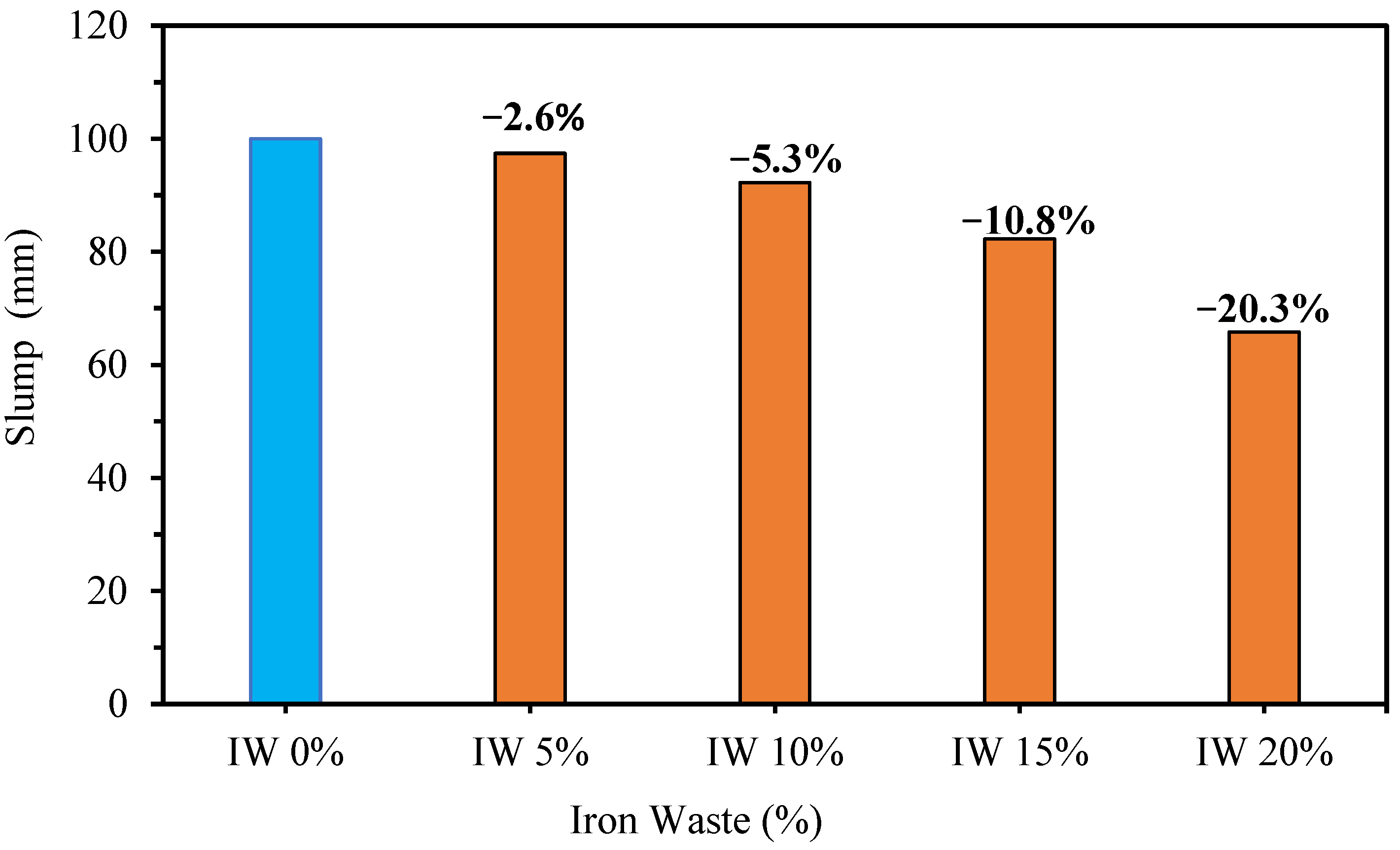
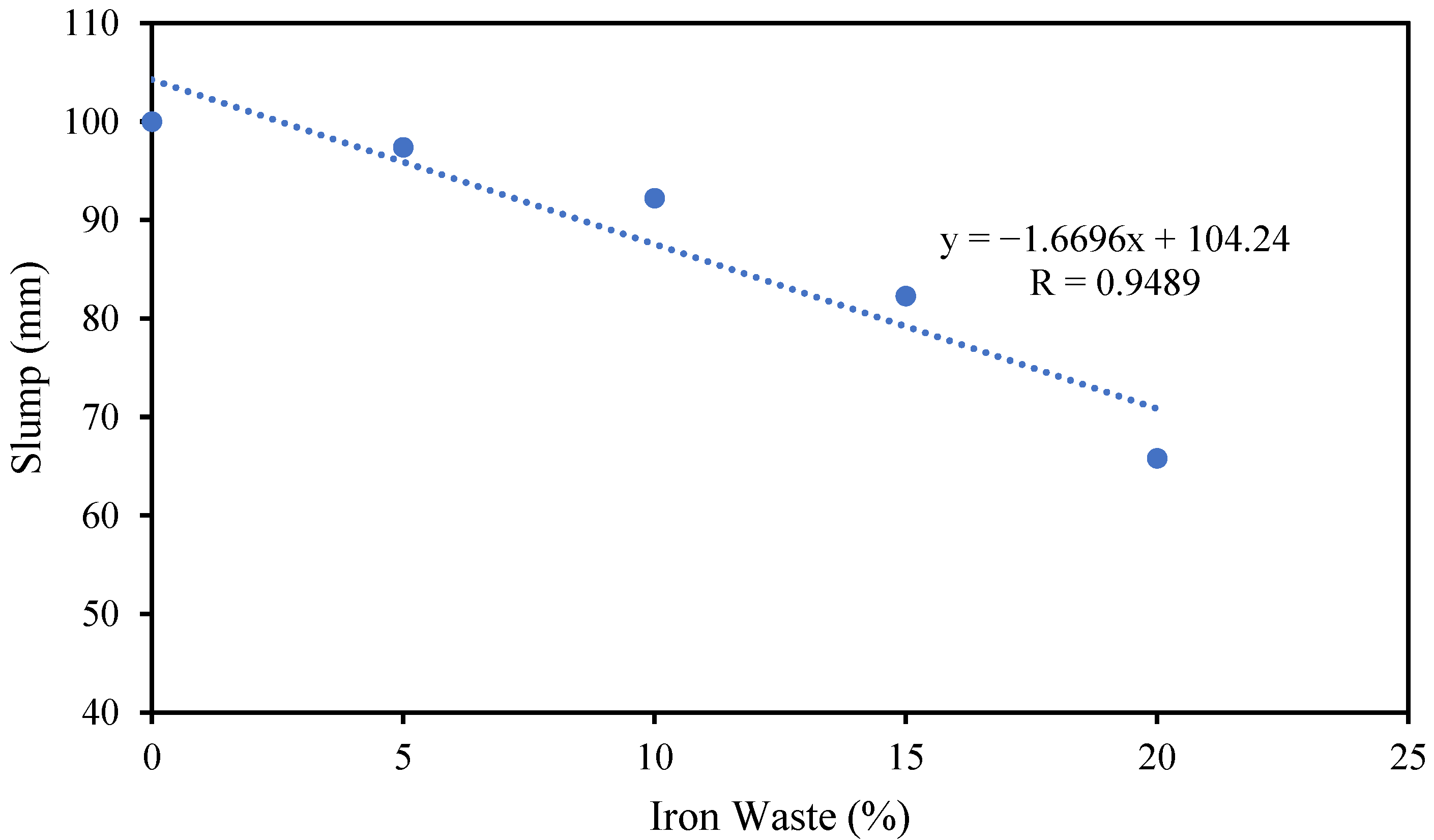
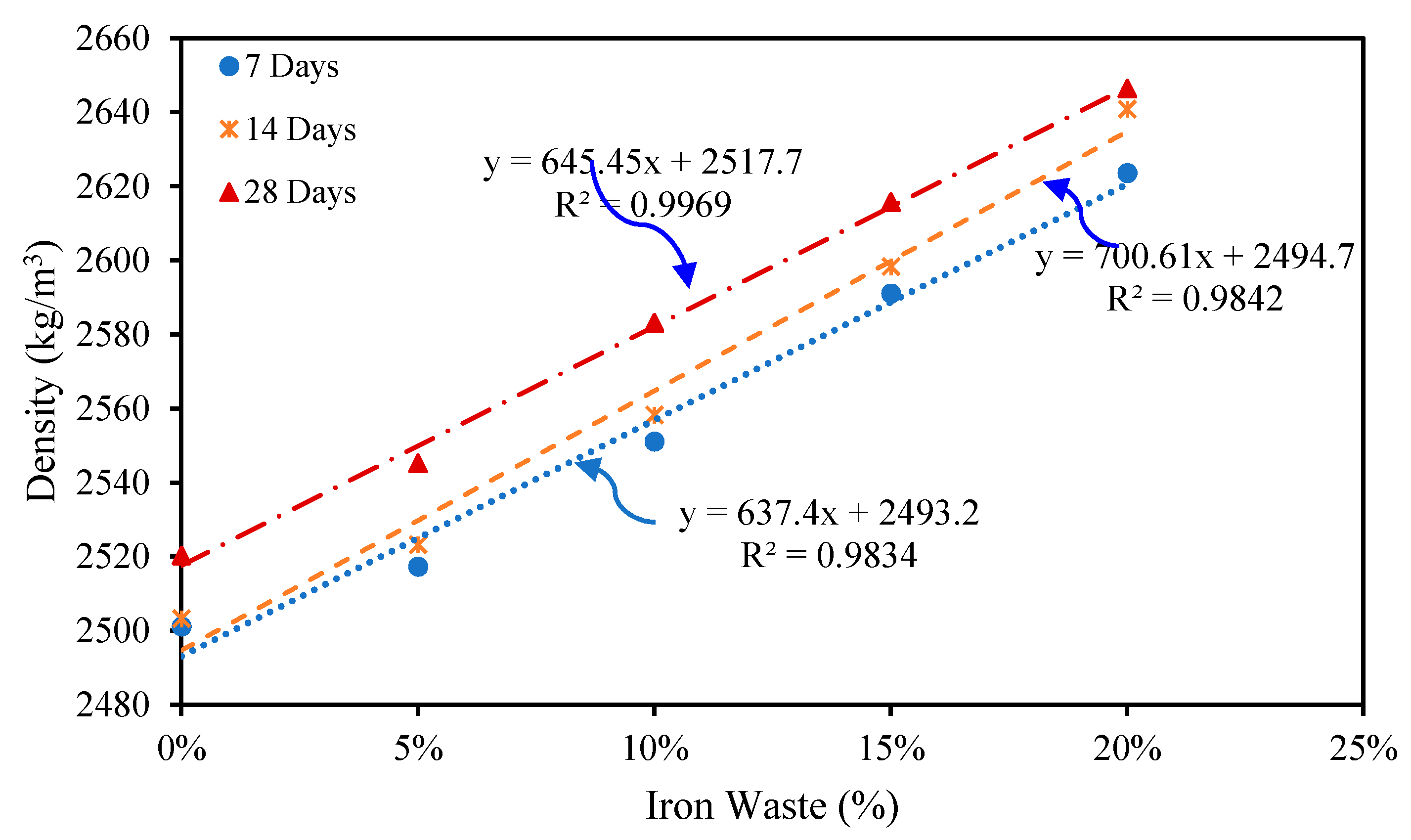
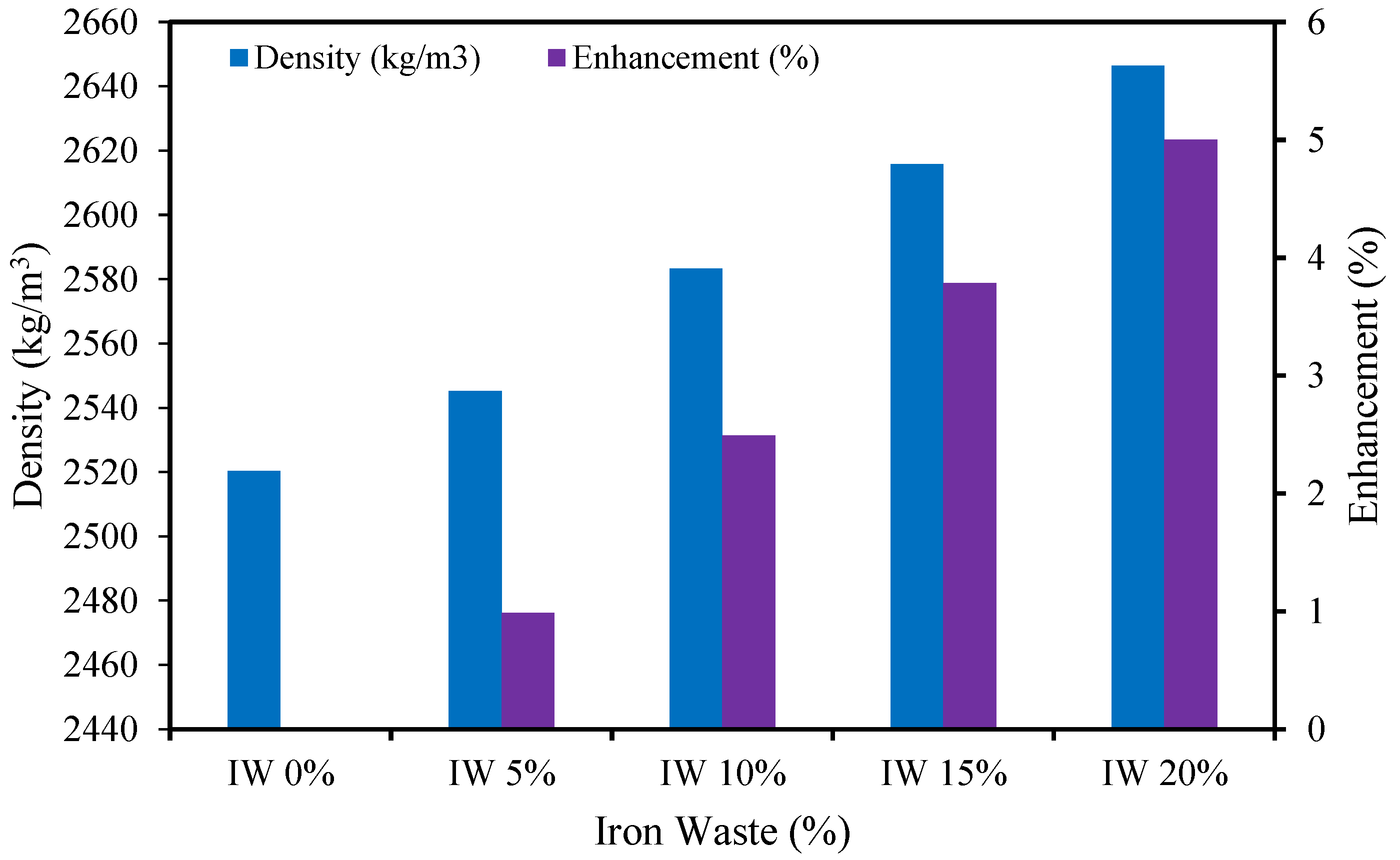
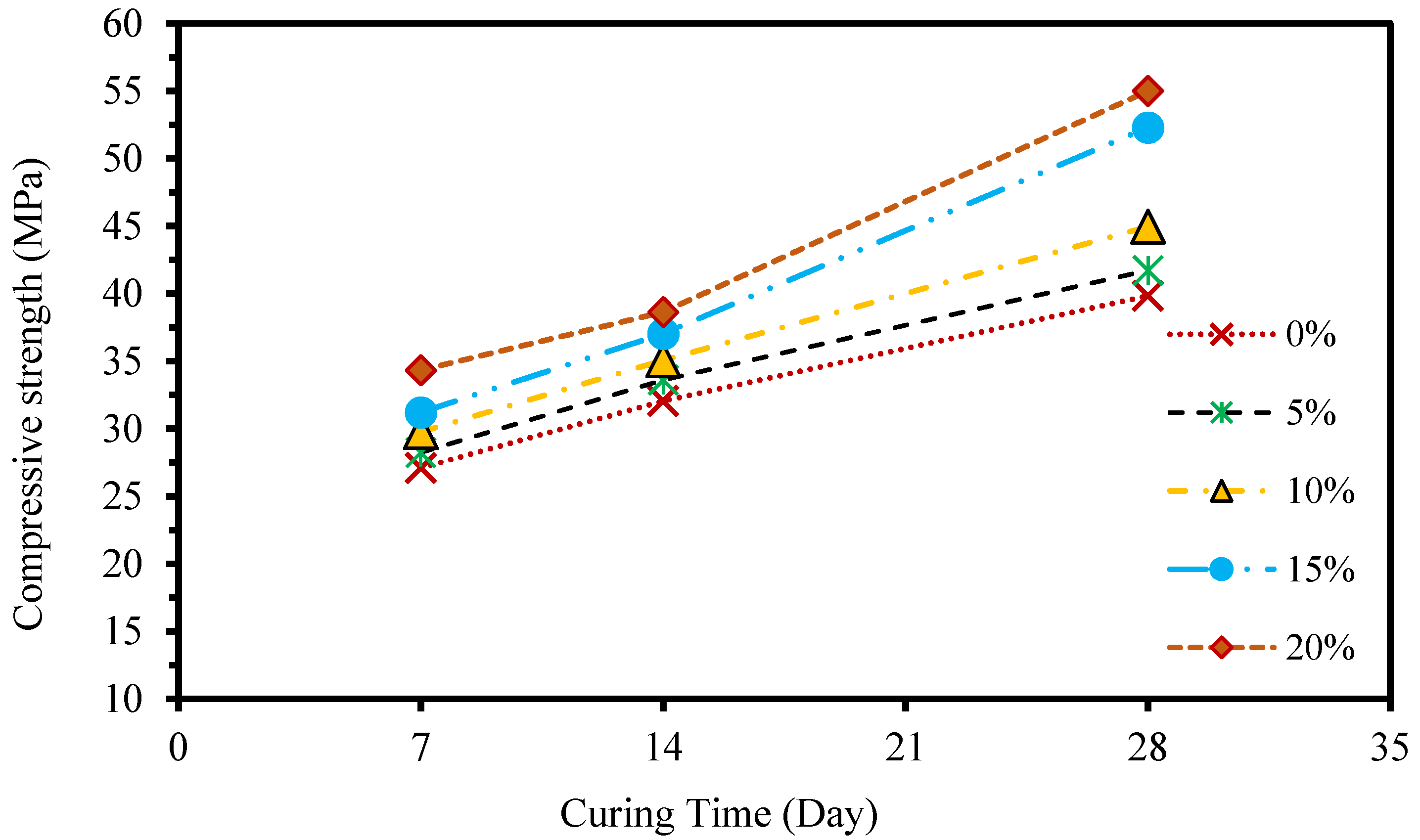
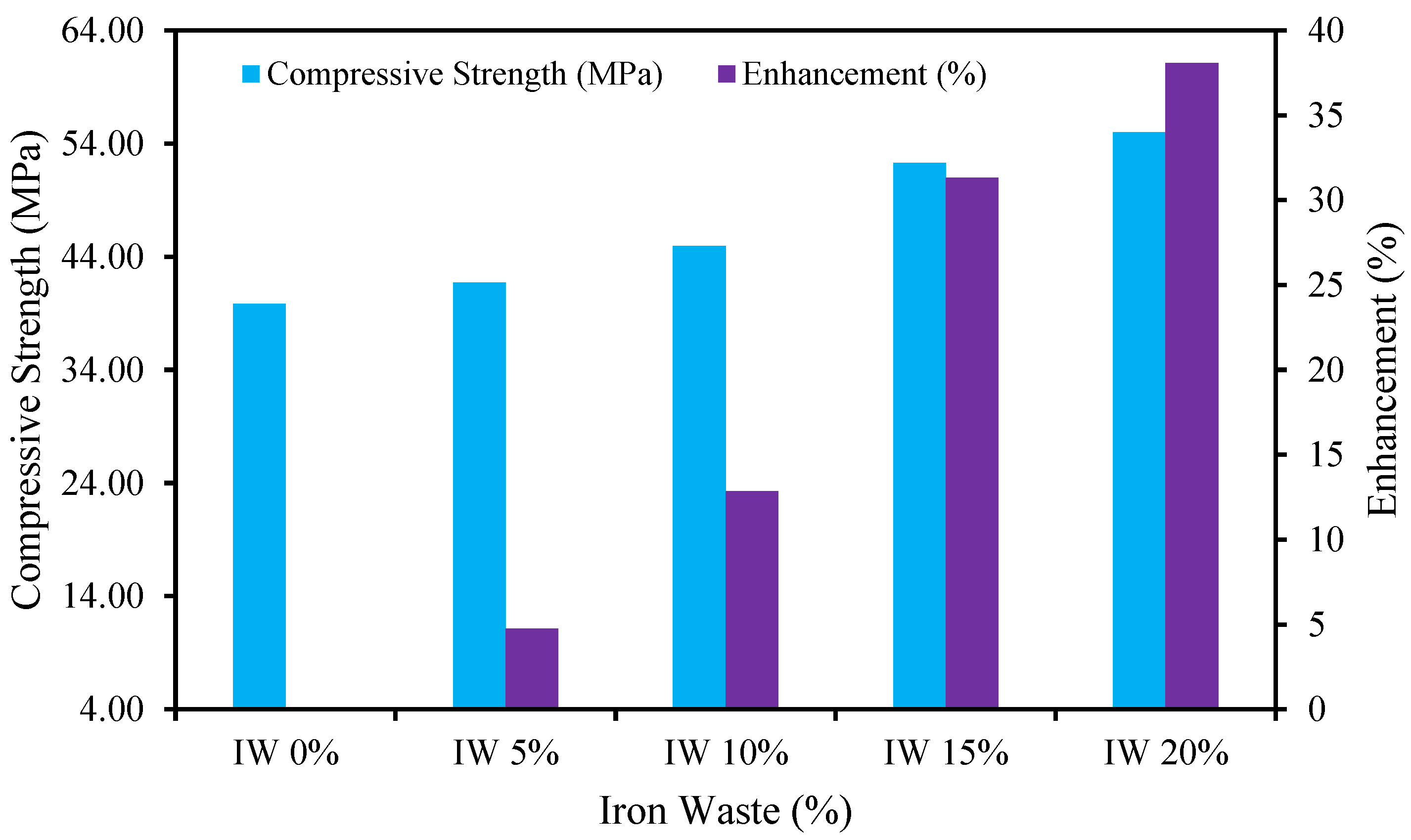
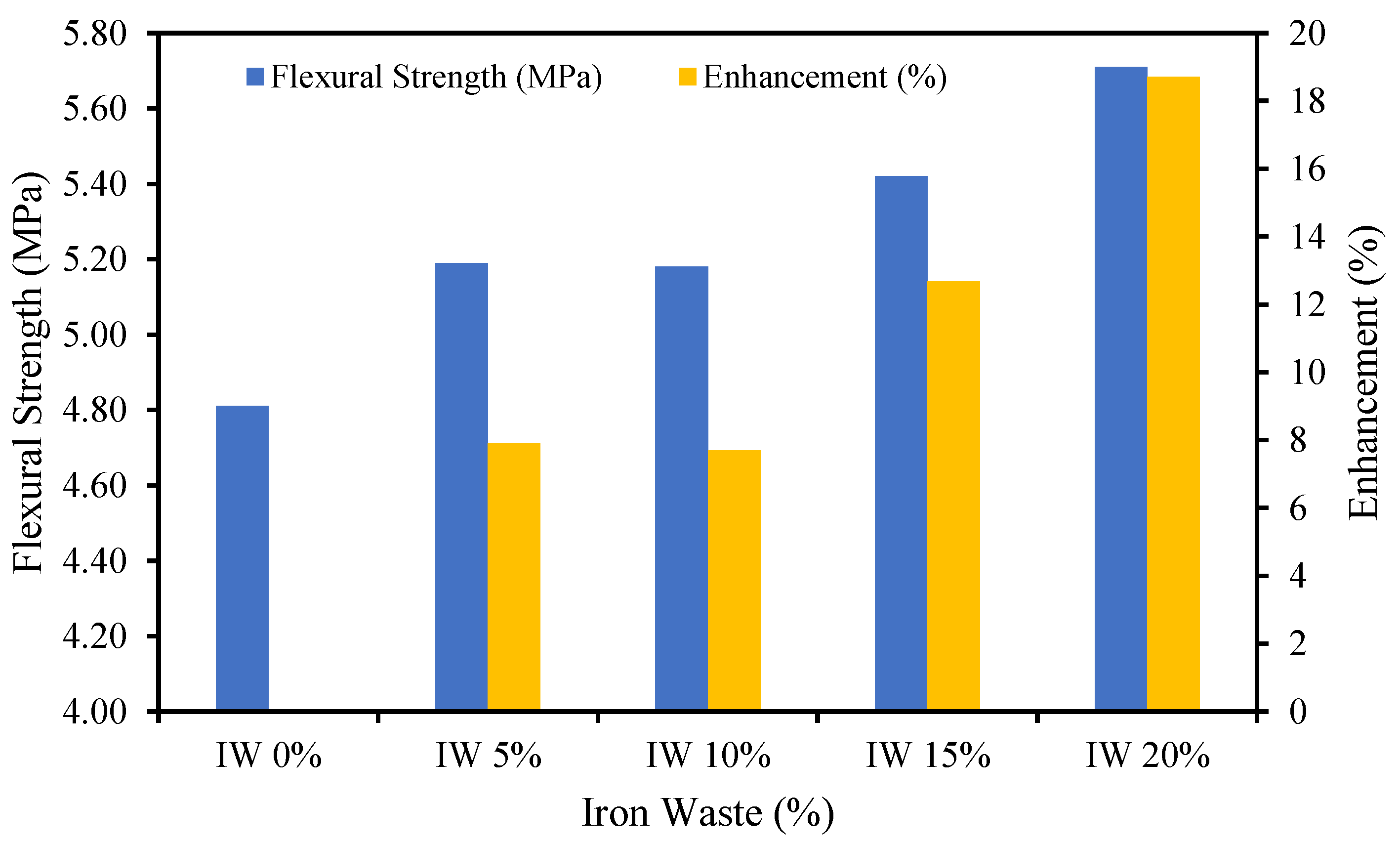
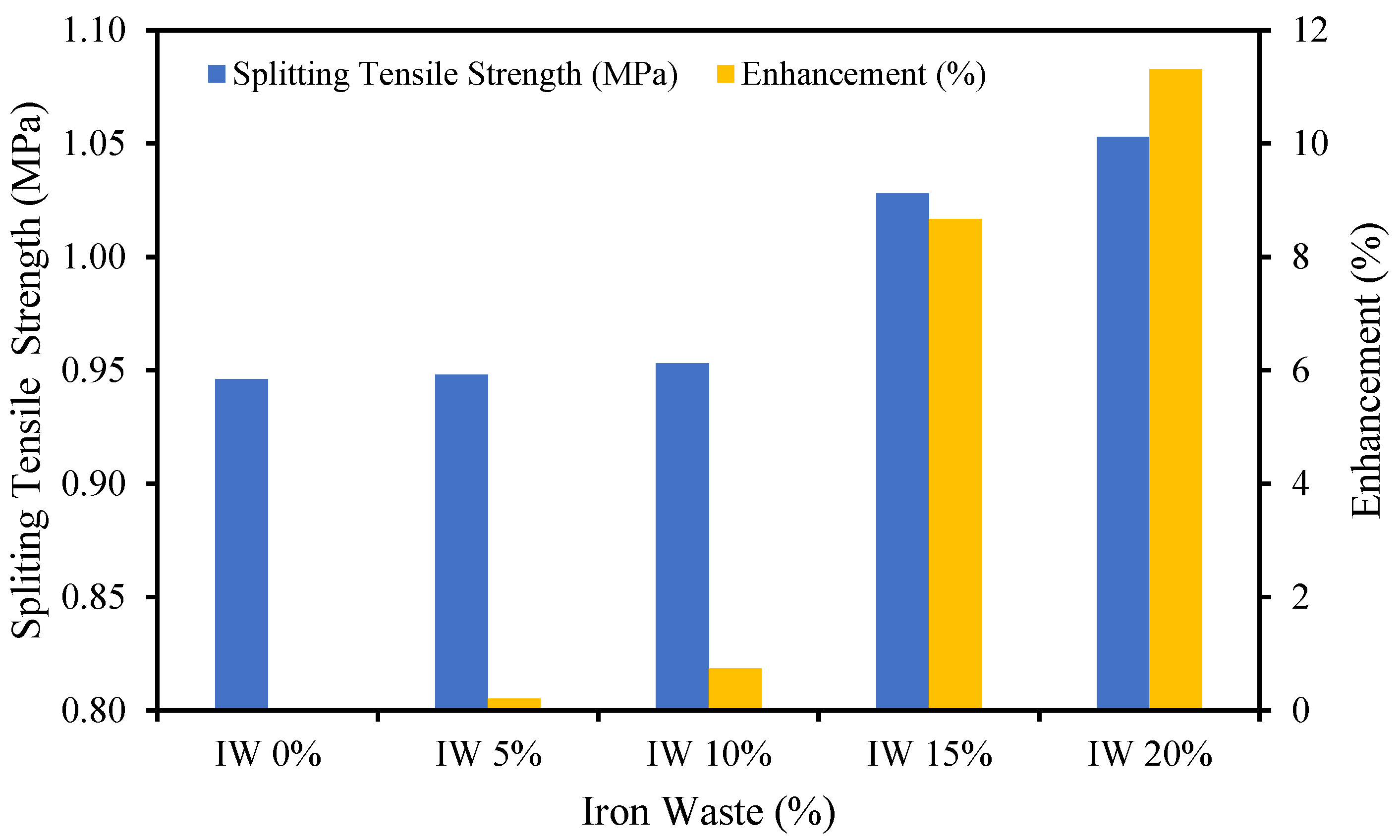
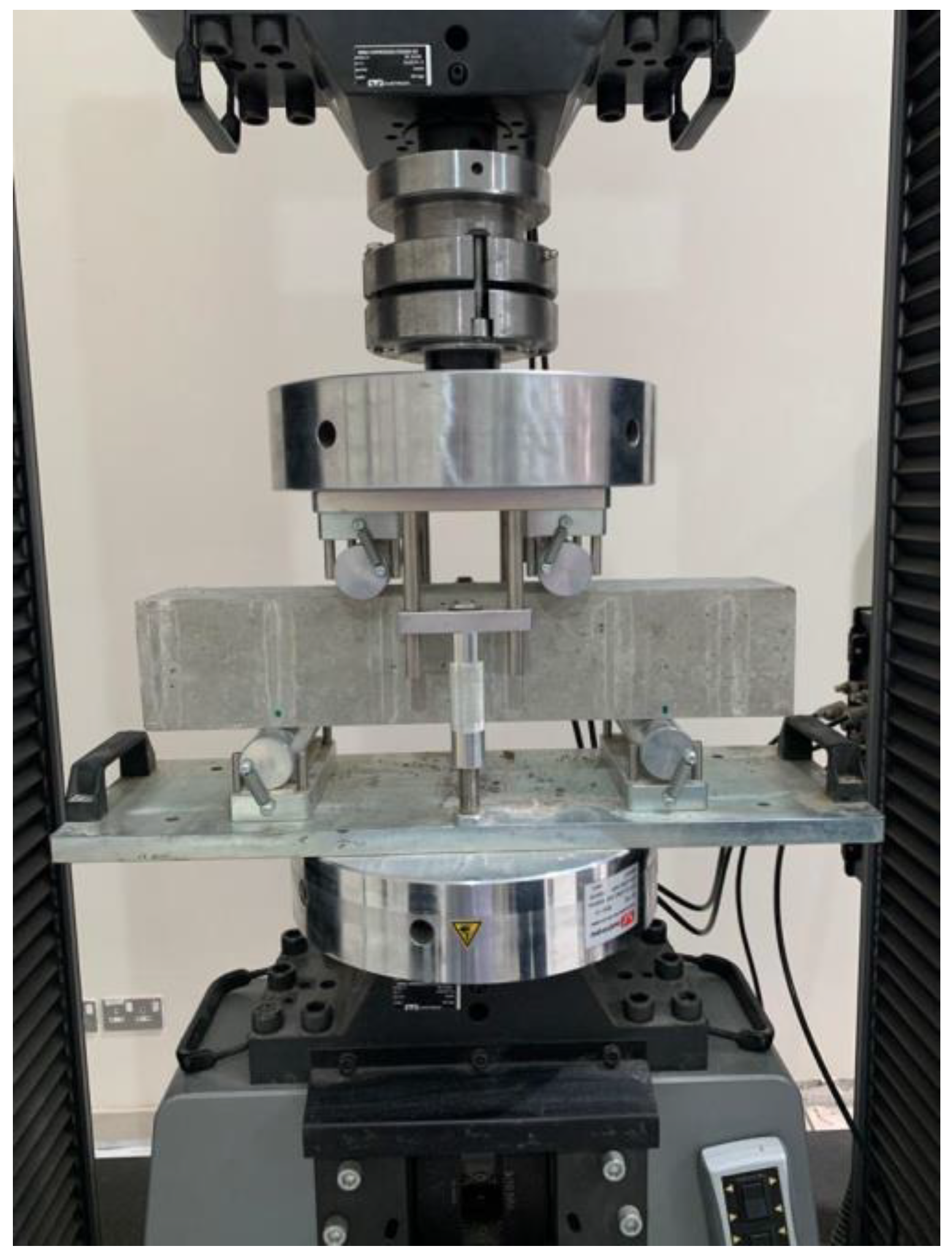
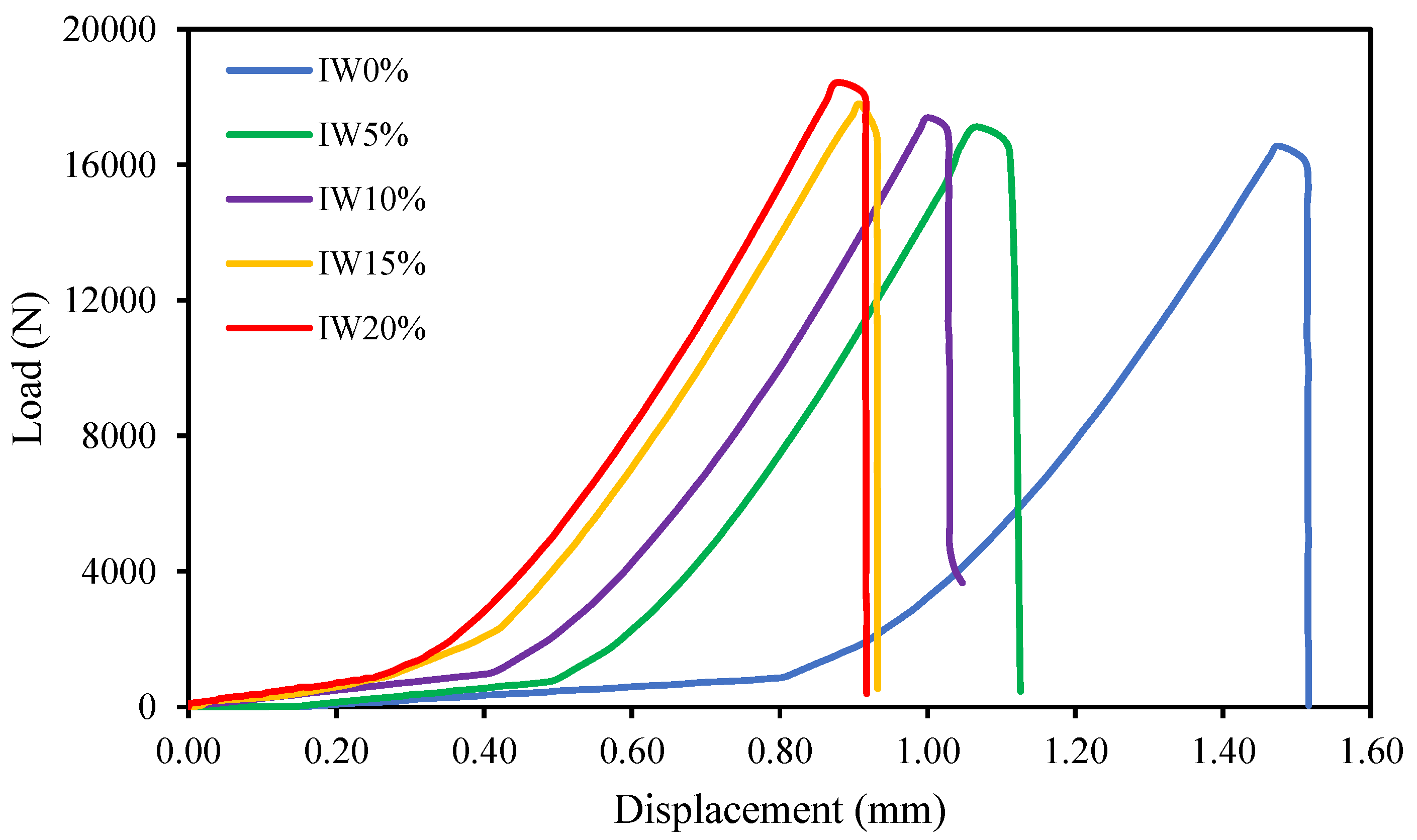
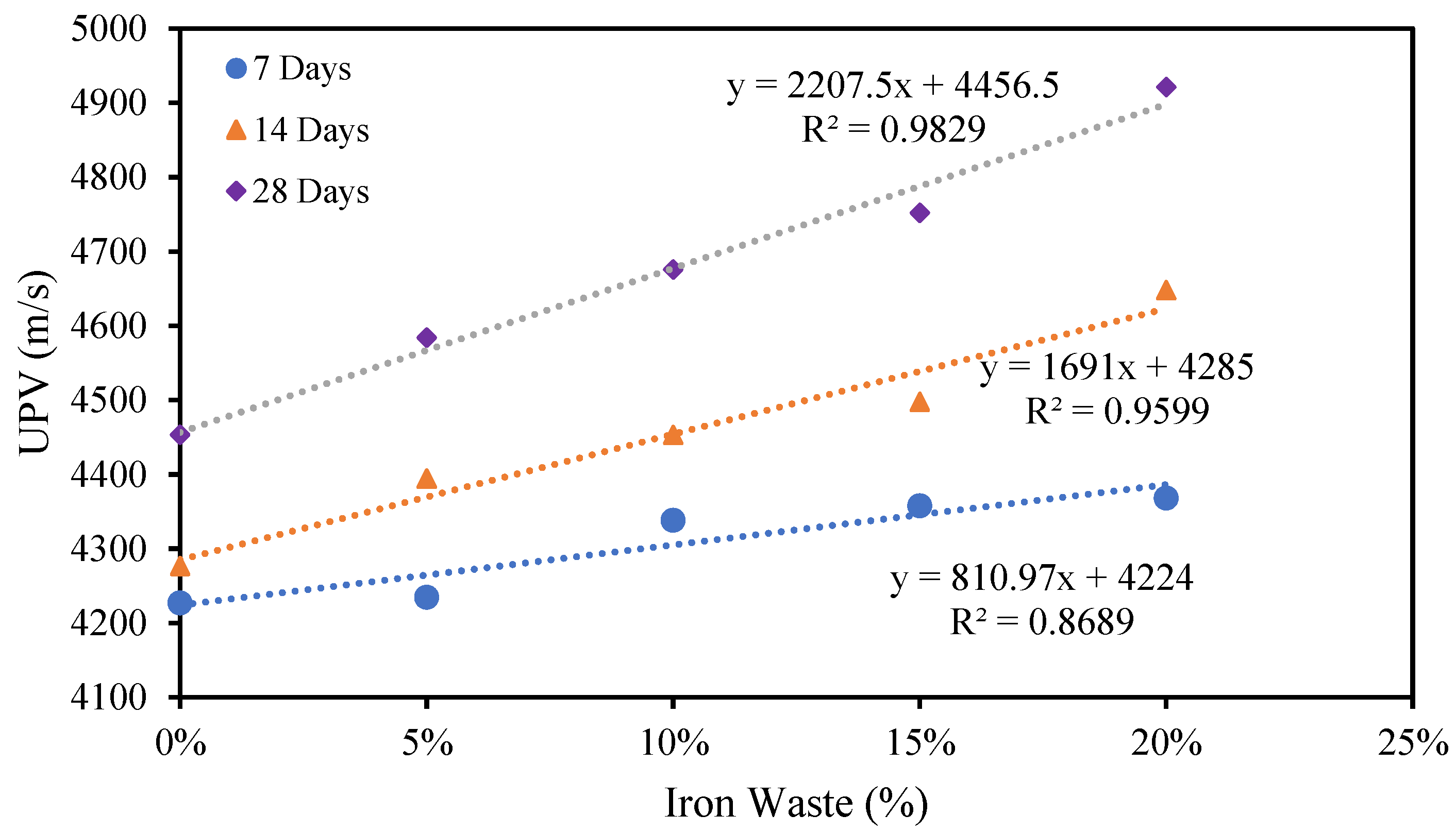
| Items | SiO2 | Al2O3 | Fe2O3 | CaO | SO3 | MgO | K2O | Insoluble | LOI |
|---|---|---|---|---|---|---|---|---|---|
| wt.% | 19.73 | 6.2 | 3.44 | 63.78 | 2.23 | 0.96 | 1.02 | 0.93 | 1.51 |
| Material | Fineness Modulus | Specific Gravity | Absorption (%) | Bulk Density (kg/m3) |
|---|---|---|---|---|
| Coarse aggregate | 7.34 | 2.77 | 0.69 | 1630.00 |
| Fine aggregate | 2.23 | 2.67 | 1.31 | 1535.74 |
| LIWD | 2.33 | 5.56 | - | 1783.00 |
| % Waste Iron | Quantity (kg/m3) | ||||
|---|---|---|---|---|---|
| Cement | Water | Fine Aggregate | Coarse Aggregate | Waste Iron | |
| 0% | 399.20 | 210.38 | 863.16 | 868.00 | 0.00 |
| 5% | 820.01 | 43.16 | |||
| 10% | 776.85 | 86.32 | |||
| 15% | 733.69 | 129.47 | |||
| 20% | 690.53 | 172.63 | |||
Publisher’s Note: MDPI stays neutral with regard to jurisdictional claims in published maps and institutional affiliations. |
© 2021 by the authors. Licensee MDPI, Basel, Switzerland. This article is an open access article distributed under the terms and conditions of the Creative Commons Attribution (CC BY) license (https://creativecommons.org/licenses/by/4.0/).
Share and Cite
Althoey, F.; Hosen, M.A. Physical and Mechanical Characteristics of Sustainable Concrete Comprising Industrial Waste Materials as a Replacement of Conventional Aggregate. Sustainability 2021, 13, 4306. https://doi.org/10.3390/su13084306
Althoey F, Hosen MA. Physical and Mechanical Characteristics of Sustainable Concrete Comprising Industrial Waste Materials as a Replacement of Conventional Aggregate. Sustainability. 2021; 13(8):4306. https://doi.org/10.3390/su13084306
Chicago/Turabian StyleAlthoey, Fadi, and Md. Akter Hosen. 2021. "Physical and Mechanical Characteristics of Sustainable Concrete Comprising Industrial Waste Materials as a Replacement of Conventional Aggregate" Sustainability 13, no. 8: 4306. https://doi.org/10.3390/su13084306
APA StyleAlthoey, F., & Hosen, M. A. (2021). Physical and Mechanical Characteristics of Sustainable Concrete Comprising Industrial Waste Materials as a Replacement of Conventional Aggregate. Sustainability, 13(8), 4306. https://doi.org/10.3390/su13084306






